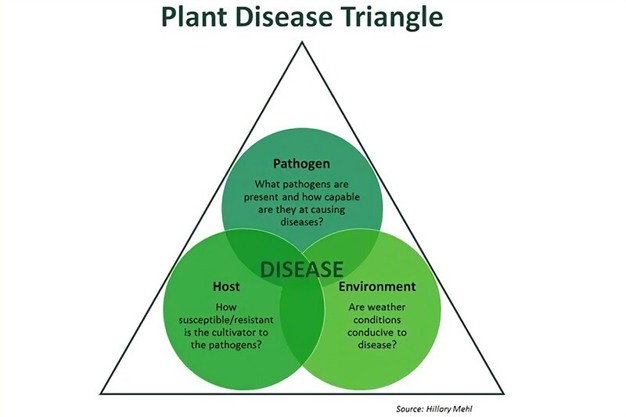Downy mildew and Botrytis diseases of roses are among the few challenges that a grower can deduce their occurrence based on the prevailing weather conditions and climate inside the greenhouse. This is primarily because the development of the two diseases is affected by climate and, to a great extent, varietal. This phenomenon is best described by the disease triangle.

The nexus of the three elements (Susceptible host, Conducive environment, and the Pathogen) leads to the occurrence of the disease. Therefore, holistic disease management looks at managing these three factors and avoiding them, providing conducive conditions for the occurrence of a pandemic in the crop. Therefore, as you prepare for the rainy season, downy mildew and botrytis control strategies should top your priority.
Quick Facts about Downy Mildew
Downy mildew (Pseudoperonospora sparsa) can be identified from the violet and brown patches on the leaves. The leaves later turn yellow and fall off. On the underside of the leaves, you often see a greyish mold. This disease thrives on a combination of high humidity and low temperature. It is prevalent in unheated crops, such as those grown in plastic tunnels and greenhouses, where temperatures fall drastically at nighttime.
Quick Facts about Botrytis
Botrytis is also called 'grey mold.' This name indicates exactly what the fungus looks like: grey powder on leaves, flowers, fruit, or the stem. The fungus penetrates the plant cells with a pollen tube, kills them, and feeds on the contents of these dead cells. Botrytis causes grey-brown spots on leaves, stems, fruits, and flowers. These grow into larger spots, after which the characteristic weft appears.

NoPath is a Koppert product that contains such essential oils and is used in the prophylactic management of downy mildew by inducing ISR. To induce ISR, NoPath should be applied to the crop by drenching to the root zone. "Overall, when crops are treated prophylactically with NoPath, growers experience less disease pressure, hence less need for curative chemical fungicide applications," the Koppert team explains.
For more information:
Koppert
[email protected]
www.koppert.com
